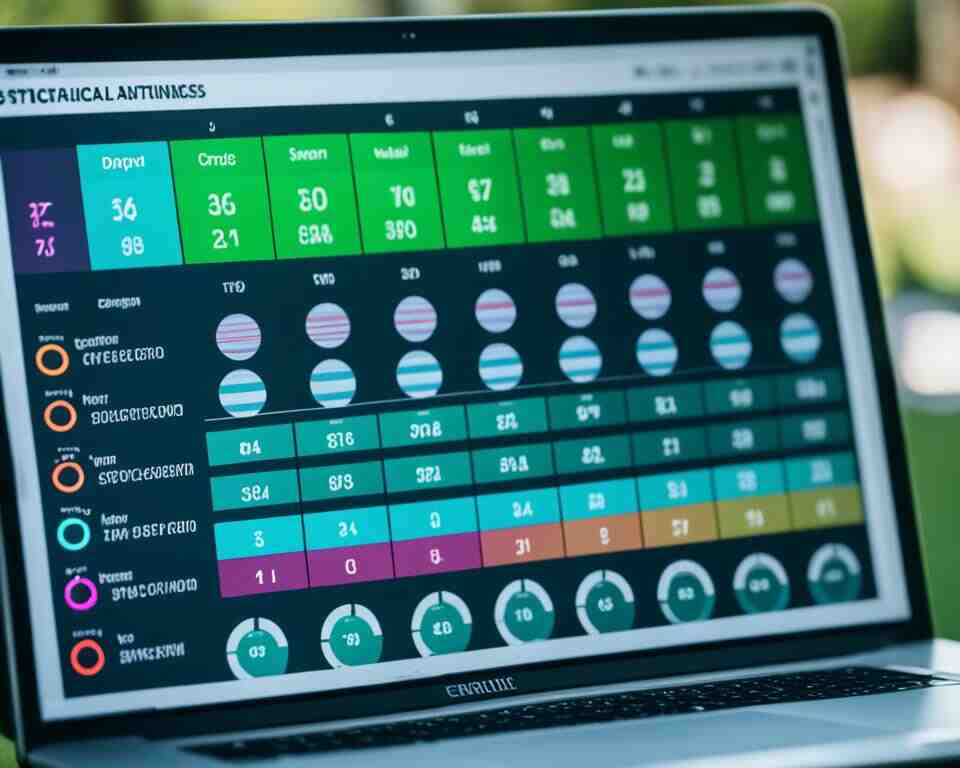Have you ever wondered how disc golf round ratings are calculated and what they actually mean? Are you curious about how your performance on the course is evaluated and compared to others? In this comprehensive scoring guide, I will dive deep into the world of disc golf round ratings and provide you with a clear understanding of how they are determined.
Disc golf round ratings play a crucial role in evaluating a player’s performance and progress in the game. They provide a standardized measure of your skill level and can be used to assess your strengths and areas for improvement. But how exactly are round ratings calculated, and what factors influence them? Let’s uncover the metrics and formulas behind these ratings to unveil the secrets of disc golf scoring.
Key Takeaways:
- Disc golf round ratings are a measure of a player’s performance and progress in the game.
- Round ratings are calculated based on specific metrics and formulas determined by the PDGA.
- The Scratch Scoring Average (SSA) and the influence of propagators play a significant role in rating calculations.
- Understanding round ratings goes beyond just the numerical value; factors like course difficulty and weather conditions should also be considered.
- Round ratings can be used as a benchmark for continuous improvement and setting performance goals in disc golf.

How Are Disc Golf Rounds Rated: Unveiling the Metrics
In order to understand how disc golf rounds are rated, it is crucial to look into the specific metrics that are used in the rating process. The Professional Disc Golf Association (PDGA) employs a comprehensive system to calculate round ratings for sanctioned singles and league rounds.
The rating metrics take into account various factors that contribute to a player’s performance on the course. These metrics encompass elements such as course difficulty, player skill level, and weather conditions. By considering these factors, the PDGA aims to provide a fair and accurate assessment of a player’s round.
Throughout the rating process, the PDGA applies these metrics meticulously to ensure that each player’s performance is evaluated objectively. By unraveling the rating metrics, players can gain valuable insights into how their round ratings are determined and how they can improve their performance on the course.
| Rating Metrics | Description |
|---|---|
| Course Difficulty | The PDGA takes into account the difficulty level of the course where the round was played. This includes factors such as the length, layout, and obstacles present on the course. |
| Player Skill Level | The skill level of the player is considered when assessing round ratings. This takes into account their history of performance and overall skill in disc golf. |
| Weather Conditions | The impact of weather conditions, such as wind and rain, is factored into the rating calculation. Inclement weather can affect a player’s performance and is taken into account when determining round ratings. |
| Propagators | Highly skilled players, known as propagators, serve as benchmarks for rating calculations. Their scores influence the ratings of other players in the same round, ensuring that ratings are comparative and reflective of performance. |
Understanding the PDGA Round Rating System
In the world of disc golf, round ratings play a crucial role in evaluating players’ performances and providing a standardized measure of skill. The PDGA round rating system is the key to understanding how these ratings are calculated and what they signify.
What Is a PDGA Rating?

Round Rating vs. Player Rating
It’s important to distinguish between round rating and player rating. A round rating reflects a player’s performance in a specific event or tournament, while a player rating is an average rating based on a player’s performance over a 12-month period.
Deciphering the Scratch Scoring Average (SSA)
The SSA is influenced by factors such as course difficulty and weather conditions. Courses with higher difficulty levels will have higher SSAs, as they are more challenging to score well on.
The Influence of Propagators on Scoring
When there are fewer than five propagators, the PDGA ratings team applies a manual process to ensure accuracy and fairness in the rating calculation.
Understanding the PDGA round rating system is essential for disc golfers looking to assess their own performance and track their progress. By mastering the intricacies of the scoring system, players can strive for continuous improvement and strive to achieve higher round ratings.
How Round Ratings Are Calculated
Round ratings are a way to evaluate a player’s performance in a round of shooting. The ratings are based on how well a player shoots compared to a hypothetical scratch player, who is considered to have a rating of 1000.
To calculate round ratings, scores from at least 5 players with ratings over 699 are used. These players, known as propagators, have their ratings determined based on at least 8 rounds of information. In cases where there are fewer than 5 propagators, or none at all, manual processes are used to assign ratings.
The first step in the calculation involves determining the Scratch Scoring Average (SSA) for each round. The SSA represents the score that a scratch player with a rating of 1000 would be expected to average on a specific course. For example, if the SSA for an 18-hole course is determined to be 50, any player who shoots a 50 in that round would receive a rating of 1000.
A player’s rating for a round is then determined based on their performance relative to the SSA. Each throw is assigned a certain number of rating points, usually around 10, for courses with a moderate difficulty level. If a player shoots worse than the SSA, their rating for that round will be lower than 1000. Conversely, if they shoot better than the SSA, their rating will be higher.
The number of rating points assigned per throw can vary depending on the difficulty of the course. For easier courses, where the SSA is lower, each throw may be worth more rating points, while for more challenging courses, each throw may be worth fewer rating points.
This variation in rating points per throw is due to a concept called “compression.” On easier courses, top players can only shoot so well, limiting the range of scores. This results in a compression or narrowing of the scores for players of different skill levels. Conversely, on difficult courses, the range of scores tends to be wider, as the challenges of the course lead to more variation in performance.
It is important to note that the SSA for a course is not fixed and can vary based on factors such as weather, season, and tournament conditions. Additionally, scores from multiple rounds played on the same course layout are used to determine the combined SSA and ratings, unless there are significant differences in wind conditions between rounds.
In summary, round ratings provide a means to evaluate a player’s performance in a round of shooting by comparing it to a hypothetical scratch player. The ratings take into account the difficulty of the course and the scores of other players to determine the relative performance of each player.
Conclusion
Understanding round ratings is crucial for any disc golfer looking to assess their performance and progress in the game. Round ratings provide a valuable measure of a player’s skills and abilities, allowing them to evaluate their performance in specific events or tournaments, and compare themselves to other players.
However, it’s important to remember that round ratings should not be viewed in isolation. Interpreting your scores goes beyond the numerical rating. Factors such as course difficulty, weather conditions, and your own skill level can influence your scores. By analyzing and interpreting these scores, you can gain a deeper understanding of your performance and identify areas for improvement.
Round ratings can also serve as a benchmark for continuous improvement. By using ratings to set performance goals and tracking your progress over time, you can monitor your development and strive for growth. Leverage your round ratings as a tool for ongoing learning and development in the sport. Take the opportunity to evaluate your performance, set new goals, and push yourself to reach new heights.
Ultimately, round ratings matter in disc golf because they provide valuable insights into a player’s performance, enable comparisons between players, and serve as a motivating force for continuous improvement. Embrace the significance of round ratings, interpret your scores beyond the numbers, and leverage them as a benchmark to propel your disc golf journey forward.


